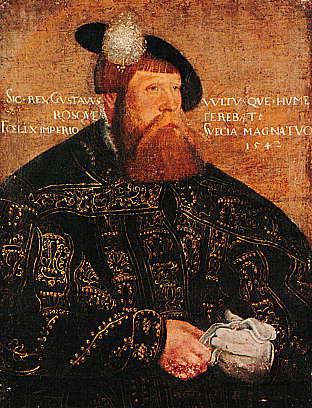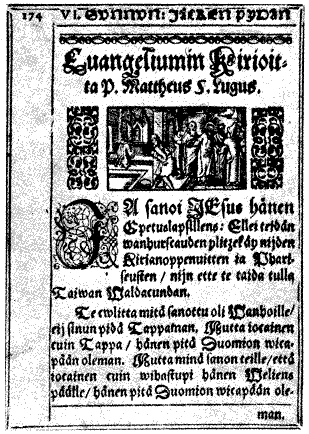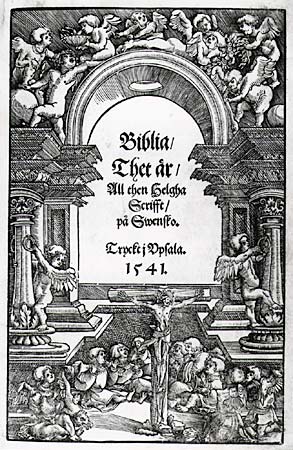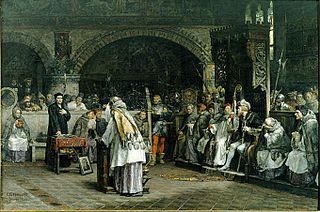
Gustav I, commonly known as Gustav Vasa, was King of Sweden from 1523 until his death in 1560, previously self-recognised Protector of the Realm (Riksföreståndare) from 1521, during the ongoing Swedish War of Liberation against King Christian II of Denmark, Norway and Sweden. Gustav rose to lead the Swedish War of Liberation following the Stockholm Bloodbath, where his father was executed. Gustav's election as king on 6 June 1523 and his triumphant entry into Stockholm eleven days later marked Sweden's final secession from the Kalmar Union.

The Church of Sweden is an Evangelical Lutheran national church in Sweden. A former state church, headquartered in Uppsala, with around 5.4 million members at year end 2023, it is the largest Christian denomination in Sweden, the largest Lutheran denomination in Europe and the third-largest in the world, after the Ethiopian Evangelical Church Mekane Yesus and the Evangelical Lutheran Church in Tanzania.

Laurentius PetriNericius was a Swedish clergyman and the first Evangelical Lutheran Archbishop of Sweden. He and his brother Olaus Petri are, together with the King Gustav Vasa, regarded as the main Lutheran reformers of Sweden. They are commemorated by the Evangelical Lutheran Church in America on 19 April.

Olof Persson, sometimes Petersson, better known under the Latin form of his name, Olaus Petri, was a clergyman, writer, judge, and major contributor to the Protestant Reformation in Sweden. His brother, Laurentius Petri, became the first Evangelical Lutheran Archbishop of Sweden.

The Catholic Church in Sweden is part of the worldwide Catholic Church in communion with the Pope in Rome. It was established by Archbishop Ansgar in Birka in 829, and further developed by the Christianization of Sweden in the 9th century. King Olof Skötkonung is considered the first Christian king of Sweden.

*Hans Brask (1464–1538) was a Swedish Bishop of Linköping.

The Archbishop of Uppsala has been the primate of Sweden in an unbroken succession since 1164, first during the Catholic era, and from the 1530s and onward under the Lutheran church.

The Archdiocese of Uppsala is one of the thirteen dioceses of the Church of Sweden and the only one having the status of an archdiocese.
Abraham Andersson, better known by his Latin name, Abrahamus Andreæ Angermannus or simply Abraham Angermannus was the fourth Lutheran Archbishop of Uppsala in the Church of Sweden from 1593 to 1599. He was described as bold and outspoken.
Nicolaus Olai Bothniensis was Archbishop of Uppsala in the Church of Sweden 1599–1600. He was appointed in place of Abraham Angermannus who had been put in prison, but before getting inducted he died of a sickness, about 50 years old.
Laurentius Andreae was a Swedish Lutheran clergyman and scholar who is acknowledged as one of his country's preeminent intellectual figures during the first half of the 16th century. In his time he was most renowned as one of the main proponents of the Swedish reformation of 1523-31.

The Diocese of Strängnäs is a part of the Lutheran Church of Sweden and has its seat in Strängnäs Cathedral in Strängnäs, south of Lake Mälaren. The diocese is made up of the two provinces Närke and Södermanland.

The Diocese of Stockholm is an exempt Latin Catholic ecclesiastical bishopric in Sweden and the only Catholic diocese established in Sweden since the Protestant Reformation. The diocese belongs to no ecclesiastical province but forms an episcopal conference with its Nordic neighbours. Its territory includes 44 parishes and covers the entire country of Sweden.
The Uppsala Synod in 1593 was the most important synod of the Lutheran Church of Sweden. Sweden had gone through its Protestant Reformation and broken with Roman Catholicism in the 1520s, but an official confession of faith had never been declared.

Ericus Erici Sorolainen (1546–1625) was a Finnish Lutheran bishop, a Bishop of Turku from 1583 to 1625 as the successor to Paulus Juusten; and the administrator of the Diocese of Viipuri.
Benzelius is the surname of a Swedish family of pastors and theologians, which originated in Bensbyn in the municipality of Luleå, from which the surname was formed in Latin.

The Reformation in Sweden is generally regarded as having begun in 1527 during the reign of King Gustav I of Sweden, but the process was slow and was not definitively decided until the Uppsala Synod of 1593, in the wake of an attempted counter-reformation during the reign of John III (1568–1592).

Johannes Matthiae Gothus was a Swedish Lutheran Bishop of Strängnäs and a professor of Uppsala University, the rector of the Collegium illustrious, Collegium Illustre in Stockholm (1626–1629) and the most eminent teacher in Sweden during the seventeenth century. He was Bishop of Strängnäs from 1643 to 1664.

Peder Galle was a Swedish Catholic priest, professor of theology, archdeacon of the Uppsala Diocese and member of parliament for the clergy.















